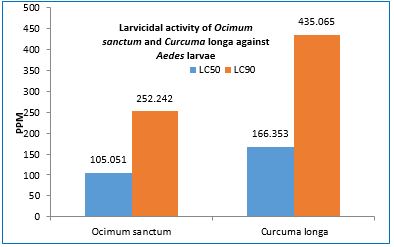Larvicidal activity of essential oils of Haridra and Tulsi against Aedes aegypti and Anopheles larvae
DOI:
https://doi.org/10.21760/jaims.8.5.3Keywords:
Mosquito larvicidal activity, Haridra, Tulsi, Aedes aegypti, Anopheles.Abstract
An attempt is made in the present study to analyse the larvicidal activity of Haridra and Tulsi against Aedes and Anopheles larvae. Larval bioassays were carried out at different concentrations 50-500ppm. The larval mortality of fourth instar larvae of A. aegypti and Anopheles after 24h of treatment was observed separately in control, 50, 62.5, 100, 150, 250, 300 and 500 ppm concentrations. Based on the Probit analysis, Significant effect (Estimate adh_conc = 3.069, 95% C.I. [2.082, 4.057], z = 6.093, p<.05) of Haridra oil extract concentration for Aedes (adh_conc) on the Probit response or mortality was observed. The median lethal Concentration, LC50= 166.353, 95% C.I. [134.745, 203.268], 90% Lethal Concentration, LC90 = 435.065, 95% C.I. [328.259, 712.462] were recorded. Statistical analysis revealed that significant effect (Estimate adt_conc = 3.369, 95% C.I. [2.229, 4.509], z = 5.791, p<.05) of Tulsi oil extract on Aedes larvae concentration (adt_conc) on the Probit response or larvae mortality (adt_mort) was observed. The median Lethal Concentration, LC50= 105.051, 95% Confidence Intervals (C.I). [81.451, 127.428], 90% Lethal Concentration, LC90 = 252.242, 95% C.I. [199.229, 376.772] of essential oil of Tulsi oil against Aedes aegypti larvae was recorded. No mortality of Aedes larvae was recorded in the control group. Essential oil of Haridra at different concentrations shows a significant effect (Estimate anh_conc = 2.038, 95% C.I. [1.180, 2.896], z = 4.655, p<.05 against the mortality of Anopheles Larvae on the Probit response or mortality. The median Lethal Concentration, LC50 = 124.823, 95% Confidence interval CI. [84.002, 164.336], 90% Lethal Concentration, LC90 = 530.978, 95% C.I. [349.474, 1333.827] of essential oil of Curcuma longa against Anopheles larvae was recorded. (Estimate ant_conc = 2.257, 95% C.I. [1.135, 3.200], z = 4.694, p<.05) of Tulsi oil - extract on Anopheles Larvae concentration (ant_conc) on the Probit response or mortality (ant mort) was observed. Median Lethal Concentration, LC50 = 339.419, 95% Confidence Interval (C.I.) [259.239, 533.727], 90% Lethal Concentration, LC90 = 1254.519, 95% C.I. [717.77, 4574.12] of essential oil of Tulsi oil against Anopheles larvae. Larvicidal activity of both the plants against Aedes larvae at different concentration was significant. But LC50 and LC90 values of Ocimum sanctum (Tulsi) against mortality of Aedes aegypti were less as compared to Curcuma longa (Haridra). It revealed that Tulsi showed better larvicidal activity against Aedes larvae as compared to Haridra. It was also observed that LC50 and LC90 values of Haridra against Anopheles larvae were less than Tulsi. It revealed that Haridra showed better larvicidal activity against Anopheles larvae as compared to Tulsi.
Downloads
References
www.mosquitoworld.net
http://www.who.int/mediacentre/factsheets/en/
S.R.Yankanchi, Omkar V. Yadav and Ganesh S. Jadhav. Synergistic and individual efficacy of certain plant extracts against dengue vector mosquito, Aedes aegypti. 2014.
Sarath Mangalat, Varun Narayanan and Minija Janardhanan. Herbal larvicides to control mosquito larvae. Jawaharlal Nehru higher secondary school mahe-673310, Pondicherry. 2004.
Bibekananda Pandey. Agnipuran. Part-2, Ist Edition, Delhi.1997.
Singh S. and Majumdar D.K. (1997). Evaluation of anti-inflammatory activity of fatty acids of Ocimum sanctum fixed oil. Indian J Exp Biol. 35:380-383.
Akshu Sharma, Manisha Dikshit, Amita Jhunjhunwala, Ashwani K. Som. Extraction process of Haridra & Tulsi essential oil with their medicinal uses. Dept. of Agad Tantra Evum Vidhi Vaidyak, Uttarakhand Ayurveda University, Rishikul Campus, Haridwar, Uttarakhand, India.















